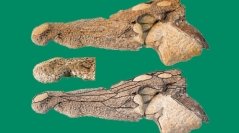

 Comptes Rendus Palevol
21 (20) - Pages 411-429
Comptes Rendus Palevol
21 (20) - Pages 411-429Here we describe a new eusuchian crocodyliform, collected 130 years ago from a shallow marine limestone of the late Eocene (Priabonian) fossil locality of Cluj-Mănăștur, Transylvania, Romania. Diplocynodon kochi n. sp. is represented by a three-dimensionally preserved incomplete skull that may have belonged to a mature individual. The new taxon possesses a relatively narrow and elongated snout and a mediolaterally shallow but anteroposteriorly wide premaxillary-maxillary notch, strengthened by a prominent bony ridge. The nasals are excluded from the naris and the anterior tip of the frontal forms a broad, complex sutural contact with the nasals. Diplocynodon kochi n. sp. possesses, similarly to other members of the genus, 16-17 maxillary alveoli of which the fourth and fifth alveoli are enlarged and confluent; the lacrimal is longer than the prefrontal; the ectopterygoid is situated close to the posteriormost maxillary tooth alveoli, the dorsal margin of the infratemporal fenestra is bordered by the quadratojugal, preventing the quadrate from reaching the fenestra, and the foramen aëreum is situated on the dorsal surface of the quadrate. The occurrence of D. kochi n. sp. in the Priabonian of the eastern part of Central Europe suggests that the genus was still present and probably widespread across the continent that contributed probably to its survival (at least locally) across the Eocene/Oligocene boundary.
Carbonate platform, Diplocynodon, faunal diversity, paratethys, Priabonian, new species